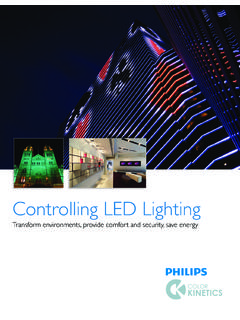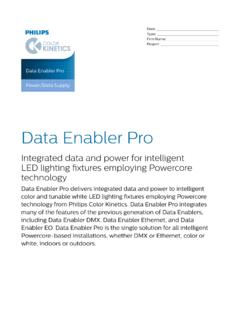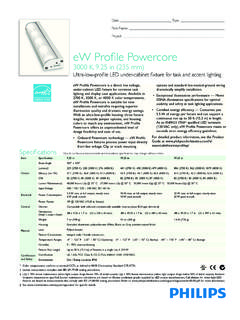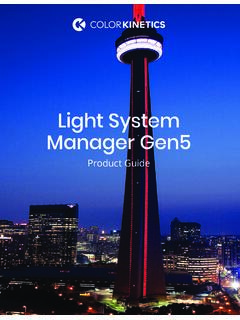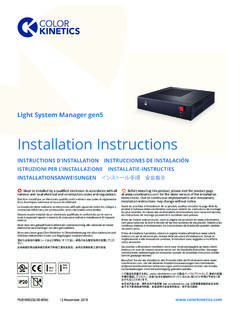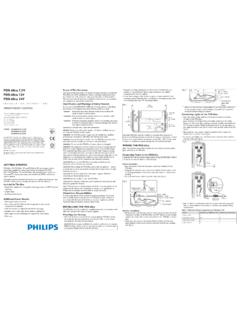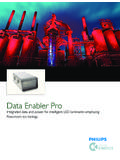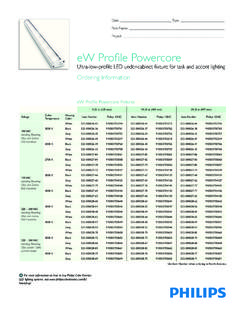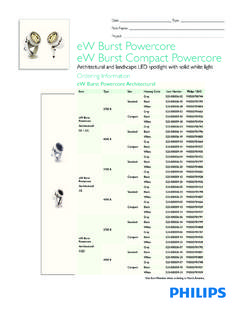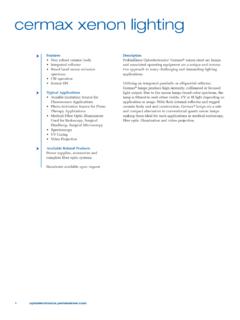Transcription of Delivered Light Output - Color Kinetics
1 Evaluating Light OutputTechnical BriefUsing Delivered Light to Specify and Compare LED Lighting FixturesEvaluating Light Output Technical Brief2 Evaluating Light Output : The Importance of Delivered LightLight Output is an informal term for how much Light a fixture produces, and how the fixture emits and distributes that Light . The formal term for data describing the quantity and distribution of the visible Light produced by a Light source or fixture is is common practice for lighting fixture manufacturers to report key photometrics in fixtures specification sheets or data sheets. These usually include basic charts and graphs that describe the power or intensity of a lamp or Light fixture, the way it distributes Light in space or over an area, and its energy efficiency. Lighting specifiers and designers use this data to make preliminary evaluations of a lighting fixture s capabilities and its potential suitability for a particular task or application.
2 Fixture manufacturers often make more detailed information available for deeper analysis, creating computer renderings, building mock-ups, and so on. The specification most commonly used for evaluating and comparing the performance of conventional lighting fixtures is lumen Output . Technically speaking, the lumen is a standard unit that measures the total perceived power of a Light source. (Exactly what total perceived power of a Light source means is discussed in more detail on page 5.) In practice, lighting professionals, purchasers, and users often refer casually to a fixture s brightness. This is not only inaccurate, but it can be misleading, especially where LED lighting fixtures are Luminaire testing labs report raw photometric data in .IES files, the format of which conforms to standards set by the Illuminating Engineering Society of North America (IES).
3 Reputable fixture manufacturers make these files available to lighting designers, who use them with lighting analysis software tools to create charts, graphs, and dimensional renderings, and to make comparisons between fixture types. Evaluating Light Output Technical Brief3 For a number of reasons, lumen Output is not the best measurement of an LED lighting fixture s capabilities. In fact, evaluating an LED lighting fixture solely or primarily on the basis of its lumen Output can underestimate or otherwise give a distorted picture of the fixture s performance and suitability for a given task or of lumen Output , the best and most relevant measurement for evaluating LED lighting fixtures and for making accurate comparisons with conventional lighting fixtures is Delivered Light . The formal term for measurements of Delivered Light is illuminance. Roughly speaking, illuminance is the intensity of Light falling on a surface area.
4 If the area is measured in square feet, the unit of illuminance is footcandles (fc). If measured in square meters, the unit of illuminance is lux (lx). Delivered Light describes how much useful Light a lighting fixture can deliver to a task area. Useful Light is the portion of a lighting fixture s Light Output that is effectively directed to a task area, discounting any wasted Light . The task area can be any space or surface that requires illumination an entrance hallway, a common office space with desktop computers, a kitchen countertop, or the face of a Mayan pyramid in Guatemala. Light can be wasted in a number of ways: It can be partially blocked or dispersed within the fixture housing, it can be emitted in a direction away from the task area, or it can be lost through filtering, lensing, fixture positioning, or any of a number of other factors relevant to a specific installation.
5 A look through The IESNA Lighting Handbook, the 1,000-page standard reference work from the Illuminating Engineering Society of North America (IES), demonstrates the importance of Delivered Light as a lighting principle, especially for white- Light and everyday applications. Along with chapters that describe in detail how to deliver the right amount of useful Light in an application, the Handbook includes an extensive lighting design guide that specifies ideal Light levels for every conceivable interior, industrial, outdoor, sports, transportation, and emergency lighting example, the Handbook recommends a Delivered Light level of around 30 fc (300 lx) for an open plan office with extensive computer use, as well as for the ticket counter of a transportation terminal. Freight elevators should have a level of around 5 fc (50 lx), while serious reading in a chair at home requires a level of around 50 fc (500 lx).
6 Lecture halls where demonstrations are being performed should have a Light level of around 100 fc (1000 lx).A computer graphic ray trace image, rendered in AGi32 lighting analysis software, from raw photometric data for ColorBlast Powercore LED fixtures from Philips Color Kinetics . The image models ColorBlast Powercore lighting effects in an exterior glass : Chris Fournier and Matt PayetteE Technically., there are lux per footcandle. However, to simplify the math, lux measurements are typically given as footcandles x 10. 30 fc is therefore equivalent to 321 lx, but is expressed as 300 lx by convention. Evaluating Light Output Technical Brief4 The Trouble with LumensThe way that lumen Output is traditionally measured, reported, and interpreted poses a number of potential problems for evaluating and comparing LED lighting fixtures:Since complete and accurate definitions of lumens and related photometric terms can be technical and complex, they are often misunderstood.
7 Without a good understanding of these terms, however, the unique properties of LED lighting sources cannot be clearly are an imperfect measurement of the perceived intensity of Light sources, with known shortcomings. The specific spectral properties of LED Light sources exaggerate these shortcomings, especially toward the blue end of the lighting fixture manufacturers often report total lamp lumens more prominently than or instead of total fixture lumens. Because many LED lighting fixtures do away with the distinction between lamp and luminaire, only total fixture lumens can serve as a basis for valid comparisons between LED and conventional lighting fixtures. LED lighting fixtures and conventional lighting fixtures are tested differently, and therefore some photometric data is reported differently. These differences must be taken into consideration in order to accurately compare conventional lighting fixtures and LED lighting fixtures.
8 A fixture s total lumen Output does not account for wasted Light . Because LED lighting fixtures are fundamentally directional and natively create white and colored Light without filtering or additional lensing and shading, LED fixtures typically waste much less Light then their conventional counterparts, and deliver more of their total Light Output to a task or target area. An LED lighting fixture with lower rated lumens, therefore, may deliver the same or more useful Light in a specific application than a comparable conventional lighting fixture with a higher rated lumen of these issues is discussed in greater detail in the sections that of eW Downlight Powercore, LED downlights from Philips Color Kinetics , and indirect lighting illuminate the dining room at Flinstering, a restaurant in Breda, The Netherlands. Recommended Light levels for dining areas such as these is about 10 fc (100 lx).
9 Photography: Korff en van MierloHow Many Watts Is That LED?Because of incandescent Light bulbs, most people are used to looking at wattage to determine the Light Output of a Light source: a 100-watt lamp puts out more Light than a 60-watt lamp. All general service incandescent lamps use the same filament material heated to the same temperature, so the only way to increase their Light Output is to increase the wattage. This is one of the main reasons why incandescent lamps are so energy Light sources are much more efficient at converting watts to lumens. Different materials can be used within the LED sources themselves, each of which has its own Light extraction efficacy. For these and other reasons, two different LED sources can consume the same number of watts but differ widely in lumen watts can t be used as an index of Light Output , evaluating the brightness of LED sources for a given situation requires you to think differently about lighting.
10 A standard 60-watt incandescent lamp emits a total of about 800 lumens, but the Light is emitted equally in all directions. When you re reading at your office desk, your book does not receive all 800 lumens from your desktop lamp, nor do you need it to. The crucial measurement is Delivered Light . According to the IES, serious reading requires an average of 50 footcandles (fc) or 500 lux (lx) on the page. Many linear LED under-cabinet fixtures and other task lights can deliver this level of Light while consuming far less than 60 watts. For example, an under-cabinet LED Light from a leading supplier can deliver 50 fc in typical desktop situations while consuming only about 6 watts per foot. Evaluating Light Output Technical Brief5 What Exactly Is a Lumen? Light measurements can either be radiometric or photometric. Radiometric measurements measure all the wavelengths of a Light source, both visible and invisible.
